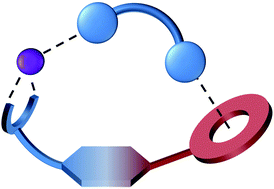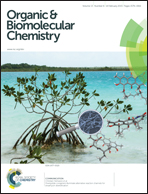Phosphate binding by a novel Zn(ii) complex featuring a trans-1,2-diaminocyclohexane ligand. Effective anion recognition in water†
Abstract
In this work we have investigated the binding properties of a new synthetic receptor for phosphate anions that combines metal ion coordination with electrostatic and H-bonding interactions. The described receptor is obtained by assembling an iminodiacetic (IDA) fragment, as a Zn(II) binding site, with a polyamine macrocyclic portion containing two trans-1,2-diaminocyclohexane (DAC) units and a pyrrole ring, as a cationic binding site, into an adaptive structure appropriately spanning the length of di- and tridentate phosphates. Potentiometric measurements together with 1H and 31P NMR investigation showed that, in a wide pH range including values of physiological interest, the Zn(II) complex of the receptor binds di- and triphosphates, such as ADP, ATP, pyrophosphate (PP) and triphosphate (TP), far better than monophosphate (MP), and that TP is poorly bound by methyliminodiacetate (MIDA) as a model for the Zn(II) binding site. Besides the excellent selectivity over other phosphates, the affinity for TP is the largest reported to date for Zn(II) complexes in water.

- This article is part of the themed collection: Supramolecular Chemistry in Water

 Please wait while we load your content...
Please wait while we load your content...